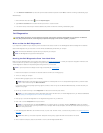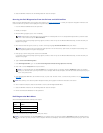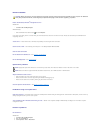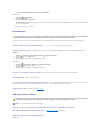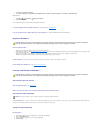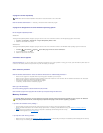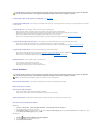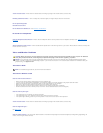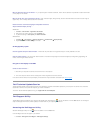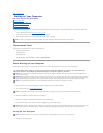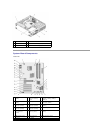
If the power light is blue and the computer is not responding — See Power Lights.
If the power light is blinking blue — The computer is in standby mode. Press a key on the keyboard, move the mouse, or press the power button to resume
normal operation.
If the power light is off — The computer is either turned off or is not receiving power.
l Reseat the power cable in the power connector on the back of the computer and the electrical outlet.
l Bypass power strips, power extension cables, and other power protection devices to verify that the computer turns on properly.
l Ensure that any power strips being used are plugged into an electrical outlet and are turned on.
l Ensure that the electrical outlet is working by testing it with another device, such as a lamp.
l Ensure that the main power cable and front panel cable are securely connected to the system board (see System Board Components).
If the power light is blinking amber, beep code 3 — The computer is receiving electrical power, but a system board failure may exist.
l Ensure that the voltage selection switch is set to match the AC power at your location (if applicable).
l Ensure that all components and cables are properly installed and securely connected to the system board (see System Board Components).
If the power light is steady amber — A device may be malfunctioning or incorrectly installed.
l Ensure that the processor power cable is securely connected to the system board power connector (POWER2) (see System Board Components).
l Remove and then reinstall all memory modules (see Replacing or Adding a Memory Module).
l Remove and then reinstall any expansion cards, including graphics cards (see PCI and PCI Express Cards).
Eliminate interference — Some possible causes of interference are:
l Power, keyboard, and mouse extension cables
l Too many devices connected to the same power strip
l Multiple power strips connected to the same electrical outlet
Printer Problems
Check the printer documentation — See the printer documentation for setup and troubleshooting information.
Ensure that the printer is turned on
Check the printer cable connections —
l See the printer documentation for cable connection information.
l Ensure that the printer cables are securely connected to the printer and the computer.
Test the electrical outlet — Ensure that the electrical outlet is working by testing it with another device, such as a lamp.
Verify that the printer is recognized by Windows —
Windows XP:
1. Click Start® Control Panel® Printers and Other Hardware® View installed printers or fax printers.
2. If the printer is listed, right-click the printer icon.
3. Click Properties® Ports. For a parallel printer, ensure that the Print to the following port(s): setting is LPT1 (Printer Port). For a USB printer, ensure
that the Print to the following port(s): setting is USB.
Windows Vista:
1. Click Start ® Control Panel® Hardware and Sound® Printer.
2. If the printer is listed, right-click the printer icon.
3. Click Properties and click Ports.
CAUTION: Before you begin any of the procedures in this section, follow the safety instructions that shipped with your computer. For additional
safety best practices information, see the Regulatory Compliance Homepage at www.dell.com/regulatory_compliance.
CAUTION: Before you begin any of the procedures in this section, follow the safety instructions that shipped with your computer. For additional
safety best practices information, see the Regulatory Compliance Homepage at www.dell.com/regulatory_compliance.
NOTE: If you need technical assistance for your printer, contact the printer's manufacturer.



